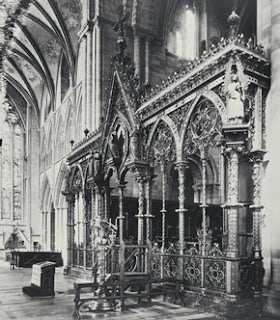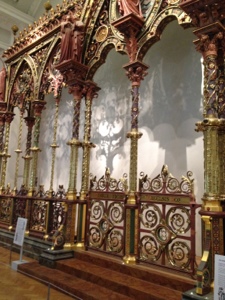Its funny that we had to travell all the way to London to see a magnificent piece of metalwork that was origionally produced and located in Hereford Cathedral. the Cthedral in Hereford is a Magnificent building that has so much character it was a real pleasure to see the restored screen in the V&A in London.
Here is a little bit of history about the Screen itself.
The great choir screen made for Hereford Cathedral is one of the monuments of High Victorian art and a masterpiece in the Gothic Revival style. It was designed by Sir George Gilbert Scott, a leading Victorian architect, and made by the Coventry metalworking firm of Francis Skidmore.
A choir screen was essential to a medieval cathedral, as the barrier that separated nave from chancel, congregation from clergy. By the 19th century, most had been removed. Scott began to reinstate this medieval feature. He was noted especially for building new churches, but began to restore old churches in the 1860s. He aimed to reintroduce a sense of architectural and spatial cohesion, boldly adding modern work to achieve this.
Scott's most impressive screens were largely of iron, as at the cathedrals of Lichfield (1861), Hereford (1862) and Salisbury (1869-72), and all were constructed by Skidmore of Coventry. Medieval screens were not made of iron - then far too costly - but always of stone or wood. Scott regarded iron as an important 'modern' material and used it extensively, both structurally and decoratively.
Before it was installed in Hereford Cathedral, the screen was one of the major exhibits at the 1862 International Exhibition in London, and was praised the Illustrated London News as 'the grandest, most triumphant achievement of modern architectural art'. It helped to win for its maker a special medal for manufacturers in metal, brass and copper, for progress, elegance of design and excellent workmanship.
The jury report on the screen described it as 'one of the most important works, not only for its size, but for the care with which it has been executed, and the successful endeavours to treat what is in fact a large architectural subject in metal alone'. Christopher Dresser later singled the screen out in his Principles of Decorative Design (1872) as 'a correct and very beautiful treatment of material, one of the finest examples of artistic metalwork'.
Celebrated in the 19th century, the screen fell from favour in the 20th century. Aesthetically, it was seen as ugly and incongruous in a medieval building. Liturgically, it was held to form an unacceptable barrier between the congregation and the chancel area. In 1967 this masterpiece of Victorian ironwork fell victim to fashionable prejudice and despite a national outcry and the protests of John Betjeman, Nikolaus Pevsner and many others, the Cathedral authorities dismantled the screen and sold it to the Herbert Museum and Art Gallery in Coventry. The Herbert lacked funds either to conserve or to house it and in 1983 gave it to the Victoria and Albert Museum. The once rusty, disintegrated pieces have now been carefully conserved, returning the screen to its former splendour








No comments:
Post a Comment